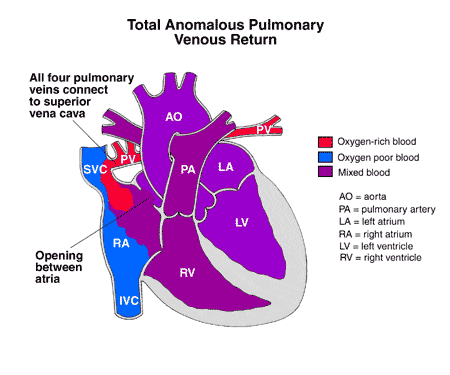
Total anomalous pulmonary venous return (TAPVR) is a heart defect that is present at birth (congenital). It happens when the fetal heart doesn’t develop correctly during the first two months of pregnancy.
Normally, the pulmonary veins take oxygen-rich blood from the lungs to the left atrium of the heart. That blood is then sent to the left ventricle and pumped throughout the body. In TAPVR, the pulmonary veins are connected incorrectly to another location in the heart. This causes the heart to be unable to supply oxygen-rich (red) blood to the body.
Other congenital heart defects are often associated with TAPVR. These defects can help the infant with sending oxygen-rich blood to the body until surgery is possible:
- An atrial and ventricular septal defect are holes in the walls that separate the two upper chambers (atrias) or lower chambers (ventricles) of the heart. These holes allow oxygen-rich (red) blood to mix with oxygen-poor (blue) blue. This new “purple” blood is then pumped to the body.
- A patent ductus arteriosus is a connection between the aorta and pulmonary artery in fetuses. It normally closes shortly after birth. But in babies whose patent ductus arteriosus remains open, oxygen-poor (blue) and oxygen-rich (red) blood mix together into “purple” blood.




